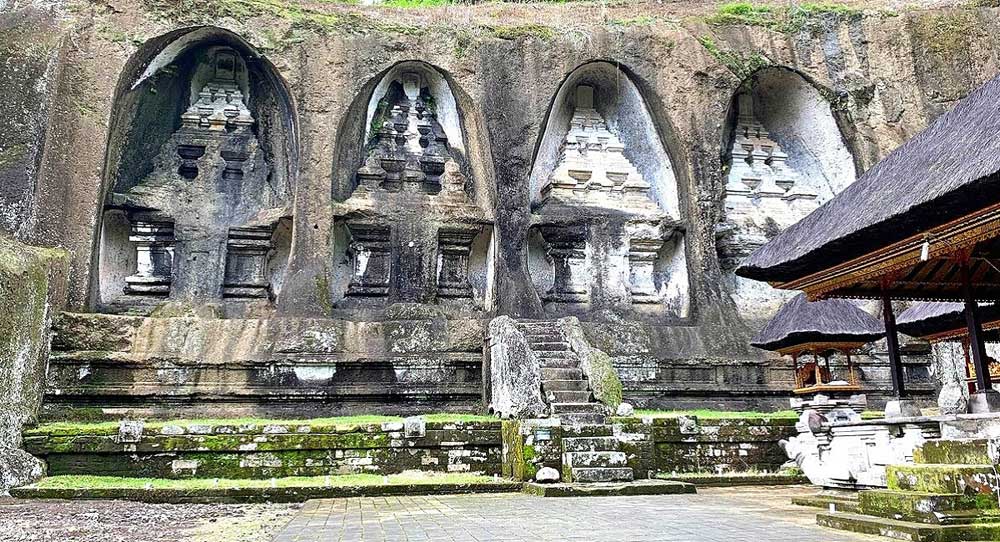 Image source: Shutterstock
Image source: Shutterstock
Nestled in a lush river valley just northeast of Ubud, the Candi Gunung Kawi temple complex is one of Bali's largest and most significant archaeological sites. This stunning temple, resembling an ancient relic of the majestic past, is not only a visual feast but also a sacred space that holds deep cultural significance for the Balinese people.
A Historical Overview
Candi Gunung Kawi is a collection of ancient shrines, known as 'Candi', intricately carved directly into the rock face of a cliff. Dating back to the 11th century, specifically around 1080 AD, it was constructed under the reign of King Anak Wungsu as a tribute to his father, the esteemed ruler Udayana, and the Warmadewa Dynasty. This extraordinary site serves as a memorial for the royal family and is believed to have also honored Anak Wungsu's wives, concubines, and notable figures from Bali's royal history.
The legends surrounding the construction of Candi Gunung Kawi are captivating; one tale speaks of the powerful military commander Kebo Iwa, who supposedly carved these monumental structures overnight using just his fingernails.
Architectural Marvel
The main complex consists of ten shrines standing in awe-inspiring 8-meter-high niches hewn into the sheer cliff face. The architectural style draws influence from the free-standing ancient temples of East Java, mirroring their forms and decorative elements. The shrines are divided by the Pakerisan River, with four located on the western side, five on the eastern side, and an additional candi to the south, possibly protected by rock-hewn cloisters.
Each candi has a distinct shape resembling a small building crowned with intricate three-tiered roofs embellished with nine stylized lingam-yoni fertility symbols. While the intricately carved facades may suggest entrances, they lead to small chambers beneath that serve as receptacles for ceremonial offerings.
Spiritual Significance
At the heart of Candi Gunung Kawi lies a rich tapestry of coexisting spiritual influences. In addition to the shrines, small stone caves serve as meditation sites where Buddhist monks once contemplated. This harmonious blend of Hinduism and Buddhism reflects the historical coexistence of both religions in Bali, making this temple not just a place of worship but also a symbol of spiritual harmony.
Across the Pakerisan River, the Pura Gunung Kawi temple courtyard complements the shrines, showcasing the essentials of traditional Balinese temple architecture, adorned with various shrines and a grand pavilion known as 'bale'.
Visiting Candi Gunung Kawi
Reaching Candi Gunung Kawi entails a descent down hundreds of steps from the main Tampaksiring highway, immersing visitors in the region’s breathtaking natural beauty, lined with art shops and local warungs. Proper attire is a must when visiting cultural sites in Bali; a sarong and sash are required, and those who are menstruating are not permitted entry to the complex. Both the sash and sarong can be rented at the ticket booth located before the steep descent.
As visitors traverse the steps, they are greeted by lush paddy terraces and verdant valleys, transporting them to a time long past. Upon entering the complex, individuals are guided through a stone archway adorned with earthen vases filled with holy water, an essential element of Balinese ritual cleansing.
A Mystical Encounter with History
Candi Gunung Kawi is steeped in ancient legends and tales of forgotten kings, invoking an atmosphere of mystique and reverence. The site is particularly vibrant during the 'piodalan' temple anniversary, celebrated during the Balinese calendar's third full moon, when the temple becomes a spectacle of colors, decorations, and festivities—creating a magical backdrop for photography enthusiasts.
In conclusion, Candi Gunung Kawi is not merely an archaeological site; it is a holy sanctuary that offers a glimpse into Bali's rich history, architectural ingenuity, and the enduring spirit of its people. Visitors are invited to explore its depths, not only to appreciate its beauty but to connect with the ancient echoes of kings and the harmonious blend of cultures that shaped this island paradise.
Conclusion
Candi Gunung Kawi stands as a testament to Bali’s ancient history, its mythological tales woven into the very stone of the cliff from which it emerges. Those who explore this sacred site will leave enriched by a deeper understanding of Bali's spiritual and cultural heritage.



